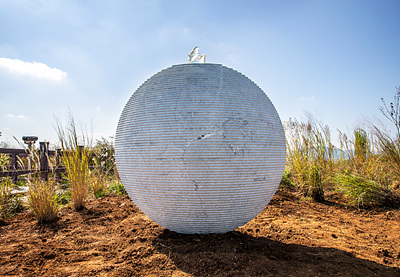 Haegue Yang and Jae-Eun Choi Participate in the 2021 DMZ Art & Peace Platform | KUKJE GALLERY
Haegue Yang and Jae-Eun Choi Participate in the 2021 DMZ Art & Peace Platform | KUKJE GALLERY
Haegue Yang and Jae-Eun Choi Participate in the 2021 DMZ Art & Peace Platform

Haegue Yang, Migratory DMZ Birds on Asymmetric Lens – Kyott Kyott Vessel (Pale Thrush), 2021, soapstone, 3D printed resin, 161×70×150 cm
Courtesy of the artist
Artists: 양혜규 (Haegue Yang), 최재은 (Jae-Eun Choi)
Exhibition Dates: September 15 – November 15, 2021
Exhibition Venues:
Paju Guard Post, Korea
UniMARU, Paju, Korea
Jejin Station, Goseong-gun, Korea
Website: https://dmzplatform.com/artists
The contemporary artists Haegue Yang and Jae-Eun Choi are participating in the group exhibition 2021 DMZ Art & Peace Platform, a presentation of works by 32 Korean and international artists which discusses the past, present, and future of Korea’s demilitarized zone. Exhibited works are displayed across five locations—UniMARU, Dorasan Station, Jejin Station, the Paju Guard Post, and the National Institute of Unification Education—spanning Paju, Goseong-gun, and Seoul, Korea. Yang’s new work Migratory DMZ Birds on Asymmetric Lens – Kyott Kyott Vessel (Pale Thrush) (2021) is introduced at the Paju Guard Post, while two recent works by Choi—To call by Name (2019) and Nature Rules (2021)—are each shown at UniMARU and Jejin Station.
Newly commissioned for the exhibition, Yang’s Migratory DMZ Birds on Asymmetric Lens – Kyott Kyott Vessel (Pale Thrush) was inspired by the audio element of birds chirping throughout the Inter-Korean Summit in 2018, which replaced the private conversation between the two leaders of the Korean Peninsula. Engraved with short Korean phrases and the work’s geographical coordinates within the DMZ, the asymmetrical, lens-shaped sculpture features a 3D printed, life-sized figure of a thrush sitting on top. Meanwhile, the bird’s disconnected head and body represents the harsh reality of a divided nation. The work references to Yang’s Migratory DMZ Birds on Asymmetric Lens series—revealed last year at the Clark Art Institute’s first outdoor exhibition titled Ground/work—which explores a narrative where these birds migrate back to the DMZ, coexisting with those that already inhabit the area.
Meanwhile, Jae-Eun Choi, an annual participant of the DMZ Project since 2015, exhibits To call by Name (2019) and Nature Rules (2021) at UniMARU and Jejin Station. The former is an installation consisting of ceramic fragments onto which the names of 106 endangered plants native to the DMZ have been engraved, evoking subjects that have once existed yet are bound to be forgotten with the passing of time. The latter showcases a biotope map placed on a miniature DMZ model, highlighting the variety of plants that construct the local ecosystem.
양혜규와 최재은, 《2021 DMZ 아트 & 피스 플랫폼》 참여
총 32명의 국내외 미술가들이 DMZ의 과거와 현재, 미래를 그리는 《2021 DMZ 아트 & 피스 플랫폼》전에 한국의 현대미술가 양혜규와 최재은이 참가한다. 오는 11월 15일까지 선보이는 이번 프로그램은 파주시 남북출입사무소의 Uni마루, 도라산역, 고성군의 제진역, 파주 철거 GP, 서울 국립통일교육원 등 총 5개의 공간에서 진행된다. 이중 파주 철거 GP에는 양혜규의 <비대칭 렌즈 위의 DMZ 철새 – 키욧 키욧 주형기舟形器 (흰배지빠귀)>(2021)가, Uni마루와 제진역에서는 최재은의 <이름 부르기>(2019), <자연국가(自然国家)>(2021) 작품 2점이 설치되어 있다.
이번에 DMZ에서 선보이는 양혜규의 신작 <비대칭 렌즈 위의 DMZ 철새 – 키욧 키욧 주형기舟形器 (흰배지빠귀)>는 지난 2018년 4월 남북정상회담의 도보다리 회담 중 두 정상의 말소리 대신 지속적으로 들리던 새소리에 영감을 얻은 작업이다. 작품 위치가 기록되어 있는 위경도 정보와 다양한 문구가 새겨진 비대칭적 형태의 동석 위에 3D 인쇄된 실제 크기의 흰배지빠귀 모형을 배치했는데, 머리와 몸통이 절단된 채 전시되고 있는 문제의 새는 우리나라의 분단현실에 대한 메시지를 내포하고 있다. 지난해 미국 클라크 인스티튜트에서 개최된 《Ground/Work》전에서 작가가 선보인 <비대칭 렌즈 위의 DMZ 철새> 연작과도 연계되어 있는 이번 작품은 DMZ 철새가 비무장지대로 돌아와 현재 그곳에 서식하는 새들과 조우하는 모습을 그린다.
한편, Uni마루와 제진역에서는 2015년부터 DMZ프로젝트를 진행해온 최재은의 <이름 부르기>와 <자연국가(自然国家)>가 전시된다. 106종의 멸종위기 식물들의 각각의 이름이 새겨진 세라믹 조각을 거울 위에 올려 완성된 <이름 부르기>는 한때는 존재했지만 점차 잊혀지는 것들의 이름과 그 존재들을 상기시킨다. 제진역에 위치한 <자연국가>의 경우, DMZ 모형 위에 비치된 ‘DMZ 생태 현황 지적도’를 통해 DMZ 생태계를 구성하는 다양한 식물군의 모습을 보여준다.
[Source from 2021 DMZ Art & Peace Platform website]